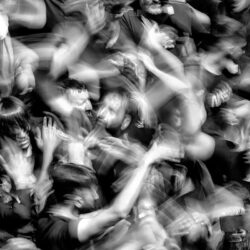Edward Hopper: An ethnographic sensibility?
 Last weekend, my wife and I went to Paris for the end of the Edward Hopper exhibition. Hopper turns out to be less well-known in the UK than I had expected, although when you show people a copy of Nighthawks, it is instantly recognized. This was the first major exhibition of his work in Europe and traced many of the connections between Hopper and post-impressionism, although he evolved a very distinctive style. Every picture of importance was included, with the possible exception of Chair Car. The exhibition was, of course, hopelessly overcrowded but seeing the originals gives a quite different sense of Hopper as a painter of light as in Morning Sun or in the way he captures the transparency of a woman’s summer dress in Summertime. It also brings out the cubist influences in the sharpness of blocking in a picture like Rooms by the Sea, where there is only light and shape to capture a moment on a summer morning.
Last weekend, my wife and I went to Paris for the end of the Edward Hopper exhibition. Hopper turns out to be less well-known in the UK than I had expected, although when you show people a copy of Nighthawks, it is instantly recognized. This was the first major exhibition of his work in Europe and traced many of the connections between Hopper and post-impressionism, although he evolved a very distinctive style. Every picture of importance was included, with the possible exception of Chair Car. The exhibition was, of course, hopelessly overcrowded but seeing the originals gives a quite different sense of Hopper as a painter of light as in Morning Sun or in the way he captures the transparency of a woman’s summer dress in Summertime. It also brings out the cubist influences in the sharpness of blocking in a picture like Rooms by the Sea, where there is only light and shape to capture a moment on a summer morning.
The collection also underlined the extent to which Hopper can be seen as a very sociological painter. One of my former graduate students, from a health professional background, commented that the thing she loved about sociology was the way in which it turned your view of the world through a few degrees so you noticed things you wouldn’t otherwise see. Hopper’s paintings constantly play the same trick. His people are placed off-centre, looking somewhere in the frame that the viewer cannot go. Similarly, his buildings tend to be examined from the edge, where the landscape (or townscape) in which they are set seems to be given equal prominence. House at Dusk is a good example, where the building occupies the lower right of the picture. We are invited both to look through the brightly lit windows at the activities of the residents and to look over the rooftop to the trees and the sunset behind. Although the painting conforms to all the formal rules of perspective, there is no obvious point to look at. The viewer’s eye wanders round wondering what it should fasten onto if it is to unlock the story of the picture. In effect, what Hopper seems to be saying is ‘here’s the world, find the narrative’. This kind of unguided eavesdropping runs right through his work. His nudes are not put on display but captured in moments of action: in Girlie Show, for example, the burlesque dancer’s audience sneaks into the very bottom of the frame – but so too does the band’s drummer, sitting with his back to the performance which holds nothing of novelty or interest for him. Intriguingly, the only human Hopper painted who looks at the viewer seems to be himself in Self-Portrait. Again he places himself off-centre, in front of a blank wall, with a door at the very edge of the frame. He is going somewhere to do something but we have no clues as to his business and his expression is as enigmatic as that of the Mona Lisa. If the door were to open, we would just become the kind of disengaged voyeurs that his vision makes us in so many of the other paintings.
Hopper is sometimes described as a painter of alienation because he depicts so many isolated figures or multiple figures who are not engaged in interaction with each other. Nighthawks is often read in this fashion, where four people in a late night diner are all locked into their own private space. Even the man and woman who seem to be a couple do not display any of the features that Goffman described as showing a ‘with’, people who were associated in some course of action. They sit slightly apart with their coffee cups in front of them gazing in parallel with no evident focus, certainly not in engagement with each other. People in the Sun might be another example, where hotel guests are sitting in deckchairs catching the morning (or evening – look at the shadows) sun without the least hint of conversation. It might be truer to say that Hopper has an ethnographer’s vision. These paintings have the same moral flatness and refusal to judge that are features of the contemporary work of the First Chicago School. The women in Summertime, Hotel Room or Summer in the City might well be hookers – but they might not. The artist’s eye brackets them with the self-evidently respectable women in Chair Car or Chop Suey. The burlesque shows that he painted, echoing Sickert’s circus paintings which he had seen in Paris as a young man are neither eroticized nor glamorized. New York Movie gives equal prominence to the silver screen and the bored usherette, who has seen the movie so many times, like the drummer in Girlie Show.
This is not a body of work that instructs us what to think – it invites us to ask the question that an ethnographer would ask: confronted with this scene, what is going on here? There is no inherent significance just endless curiosity. It is a useful reminder that participant observers need eyes as well as ears – and maybe that our methods courses might usefully incorporate reviewing works of art as well as IRB forms.
READ RELATED ARTICLES
Provoked by Boredom: Experiences from Youth Confinement
Research Ethics and James Bond
OA and the UK Humanities & Social Sciences
Gangster Anthropologist






























































































What a lovely analysis.
I especially like the connection to Goffman, as Goffman is the most ‘aesthetic’ of sociologists: his sociological work is to see how aesthetic, dramatic, and theatrical devices play a structuring role in social life.
For Goffman, privacy and publicness are intertwined. And you latch on very well, I believe, to the way the viewer’s observation is a part of Hopper’s work.
Beautifully done.